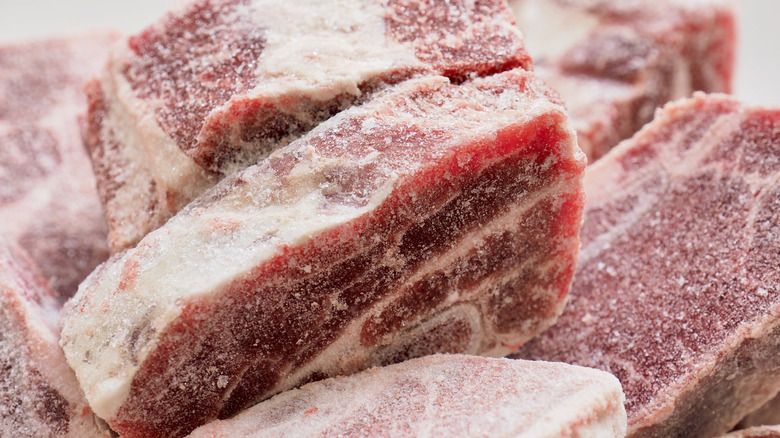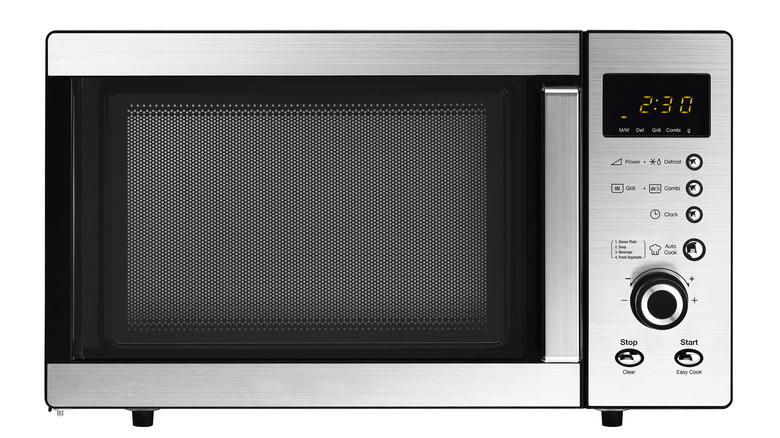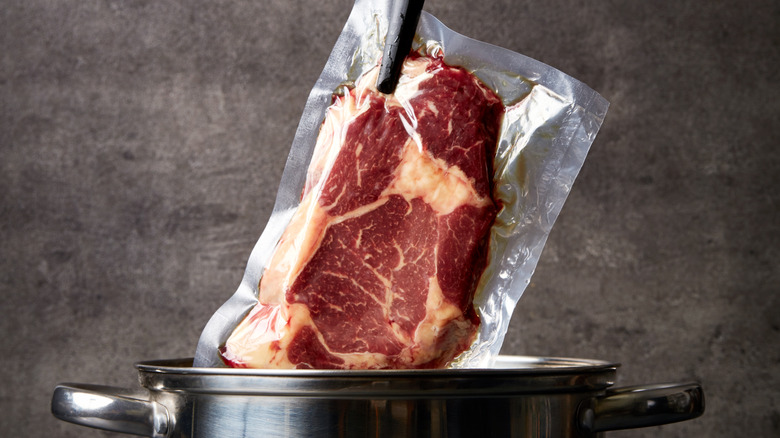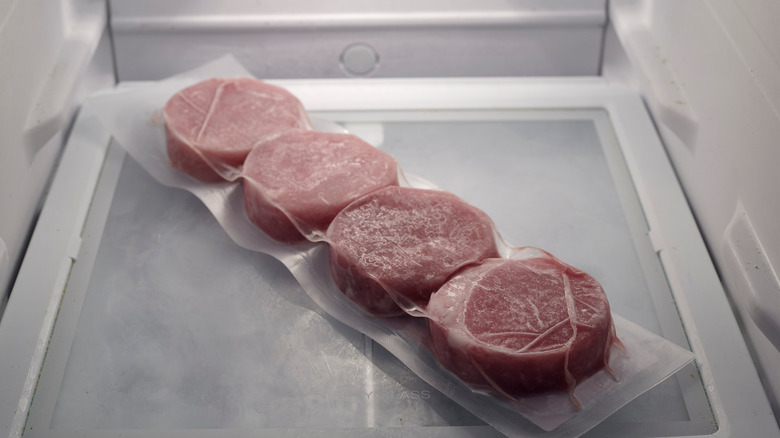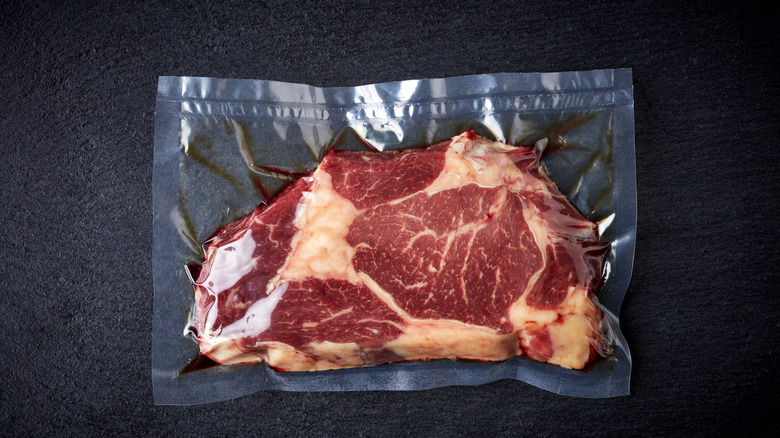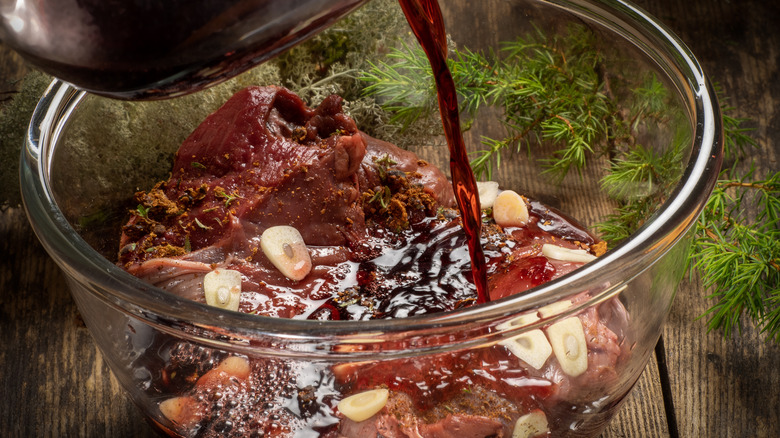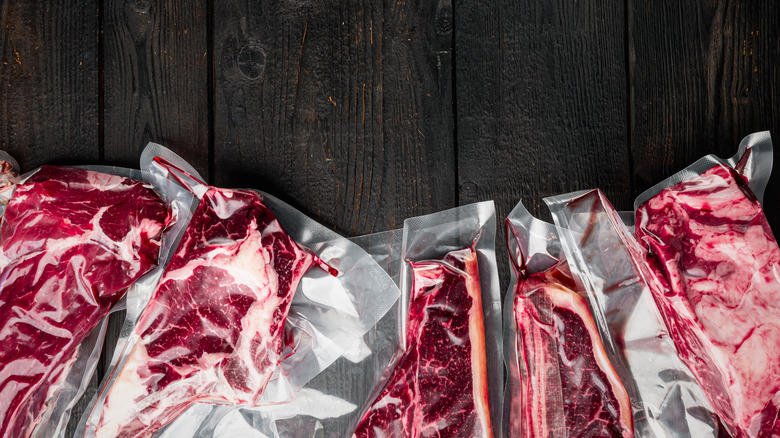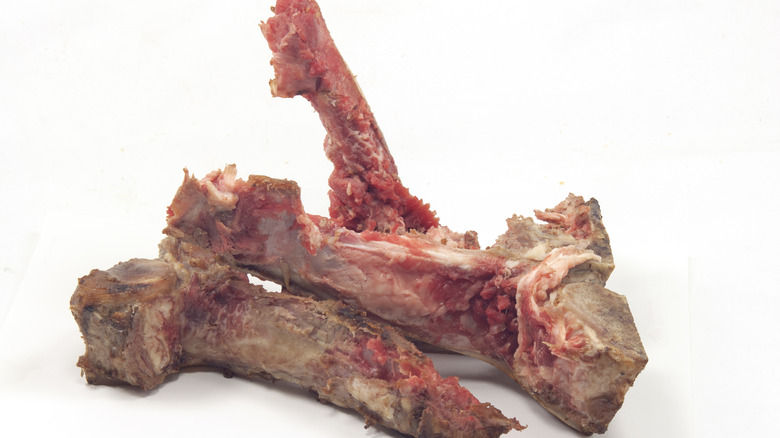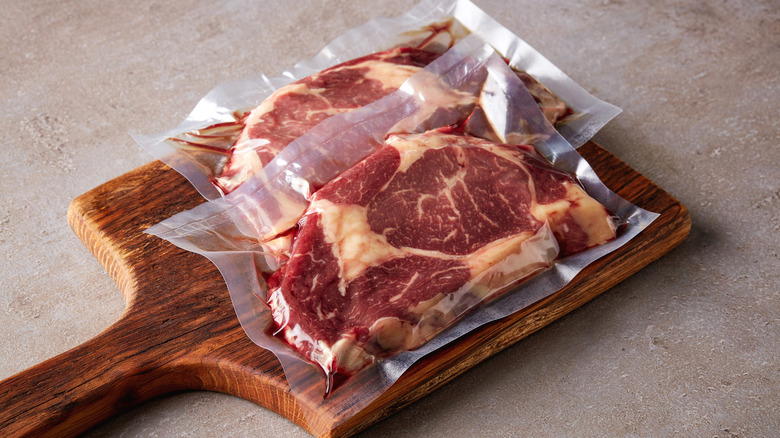8 Mistakes Everyone Makes When Defrosting Steak
Whether you're buying frozen steaks from the get-go, sourcing beef in bulk and portioning it for later, or simply tossing fresh steak in the freezer when your dinner plans change, chances are you've got at least a bit of beef in the icebox. But did you know that how you defrost your steaks can make or break them in terms of flavor, texture, quality, and even safe consumption?
Mistakes people make when defrosting frozen steak include a few methods that might seem safe or common, such as microwaving steak on the "defrost" setting (that's what it's there for ... right?) or even leaving the steak out on the counter as our parents did when we were growing up. But going down those paths contribute to a higher risk of food borne illness, not to mention a drier, less tasty steak. By eschewing these common mistakes, you'll end up with a far more delicious steak that's totally safe for your family to consume.
Using the microwave
While rumors that microwaves are dangerous are certainly overwrought, the microwave is not the place to defrost your steak — defrost button be damned.
Look, we get it: Defrosting food in the microwave is quick and easy, and on nights when you barely have time to pull dinner together, it can seem like a lifesaver. But as food scientist Costas Stathopoulos, a professor at Abertay University in Dundee, tells the Daily Mail, it's a problematic solution for more reasons than one.
First off, defrosting steak in the microwave can cause some areas of the steak to start to cook, resulting in an unevenly cooked or even dry steak later. But even more importantly, microwaves can bring steak into what the USDA calls the "danger zone," a range of between 40 and 140 F that's the ideal temperature for bacteria to multiply and risk making your steak more dangerous to eat.
Using hot water
Soaking steak in hot water certainly defrosts it quickly, but it's a big no-no from both a flavor and a food safety standpoint according to The Kitchn. Since the USDA-defined "danger zone" for meat hovers between 40 and 140 F — which, as we mentioned, is a temperature range that paves the way for bacteria to multiply and contaminate your meat — submerging steak in hot water is just asking for food poisoning.
To add insult to injury, this quick-thaw method also causes the steak to lose moisture, leading to a drier, tougher steak once you cook it. For your health and for the gustatory pleasure of the final result, then, it's best not to resort to quick-thaw methods like this one. Instead, it's best to rely on slower, safer thawing methods to bring your steak up to temperature and prepare it for the cooking method of your choice.
Using pretty much any method other than the fridge
The safest method for thawing steak isn't to rely on the microwave or a hot water bath or even to leave it out on the countertop. Instead, experts agree that it's best to defrost steak slowly in the fridge.
And when we say slowly, we mean slowly. Chicago Steak Company recommends giving steaks at least 24 hours to defrost at a cold temperature. This not only prevents bacteria growth, but, according to The Kitchn, it allows the meat to reabsorb the moisture it releases, resulting in a tender, delicious steak once cooked.
Chicago Steak Company notes that pretty much any attempt to speed up this process is likely to contribute to a tougher steak that may be riskier to feed your family. So forget about the microwave, the countertop, or a hot water bath, and instead, plan ahead. You'll be rewarded with a much more delicious final product.
Unwrapping sous-vide steak before thawing
If you're freezing steak at home, it's best to take an extra step before throwing it into the icebox. Instead of putting it into a simple zip-top bag — or worse, freezing it in the grocery store plastic wrap — it's best to first seal it sous-vide. According to the Canadian National Center for Home Food Preparation, using a vacuum sealer keeps your meat fresher for longer and prevents it from becoming oxidized and discolored by contact with the air.
As an added bonus, sous-vide steak is also easier to defrost without risking it drying out. Instead of unwrapping steaks the moment they come out of the fridge, simply leave them in their sous-vide packaging and place them on a plate to defrost. They'll reabsorb the moisture they release, so the resulting steak will be tender and delicious. And to top it all off, your fridge will stay neater!
Neglecting to take advantage of thawing time to enhance flavor
One exception to the guideline of always defrosting steak in its sous-vide packaging is if you want to add extra flavor to your steak. And why wouldn't you? Foods Questions recommends marinating for improved flavor but also texture, and as an added bonus, it can even help it thaw faster. This is due to a number of factors. First, the ice crystals that form on the frozen steak act as an abrasive to tenderize the meat. Secondly, frozen steaks will soak up the marinade as they thaw, and since many marinades contain salt, which draws the liquid out of the meat and causes the ice to melt, this step can, in turn, help the steak thaw more quickly.
Foods Questions recommends marinating frozen steak for between eight and 12 hours in a freezer bag. The Kitchn suggests using a glug of balsamic vinegar as a quick and easy marinade that tenderizes the meat and adds even more flavor as it defrosts, but these marinade recipes ranging from the simple to the complex offer even more options.
Some even suggest freezing the meat in its marinade from the get-go, so the steak is exposed to the flavors of the marinade both before and after freezing.
Forgetting about the one quick-thaw method that is actually safe
If you're really strapped for time, there is one quick thaw method for steak that's actually safe: setting it, either vacuum sealed or in an airtight zip-top bag, in a bowl of cool water. This method takes about 30 minutes per pound of meat, so it's not nearly as quick as hot water or the microwave, but it's significantly faster than the hours it would take in the fridge, and according to Real Simple, done properly, it will not discolor the meat or bring it into that dreaded USDA "danger zone" between 40 and 140 F — you know the drill: bacteria congregate, leading to tainted beef, which is an invitation for food poisoning.
The one caveat with this method? The center of the meat might still be a bit cold when you begin cooking it. To remedy that, cook your steak a little longer to ensure you reach the temperature you were going for.
Not eating it quickly enough
Let's say you had the foresight to take your steak out of the freezer and thaw it in the fridge a day before ... only to switch gears and grab pizza for dinner instead. What can you do? If you opted for a safe thawing method, according to the USDA, you can safely keep the steak in the fridge for three to five days before cooking. But if your cooking plans for the week have completely changed, the USDA notes that you can choose to refreeze your steak within that window.
Of course, if you opted for a quick-defrost method, you could be headed down the highway to the USDA "danger zone" and leaving your steak in the fridge for another few days will only make things worse.
Long story short? If you quick-defrosted your meat, best to eat it as soon as possible. If you defrosted it slowly, eat it within the week (and sooner rather than later!)
Defrosting it at all!
There is one instance where you may be able to forego all defrosting: If your steak was purchased sous-vide — or if you packaged it sous-vide yourself before freezing it. We're not suggesting that you dig into frozen steak — far from it. Rather, you can cook sous-vide steak straight from frozen, which helps it retain all its moisture and keeps it from reaching the USDA-defined "danger zone." Top Sous Vide offers a step-by-step guide to cooking frozen meat sous-vide, including temperature and timing for medium-rare, medium, and well-done steaks.
One thing to keep in mind, however, is this process will take some time. If you're cooking a frozen T-bone steak, for example, Top Sous Vide suggets leaving it in a 132.8 F water bath for 135 minutes, which is 45 minutes longer than they recommend cooking a T-bone that isn't frozen. The last step after the steak is cooked through will simply be to sear it in a cast iron skillet (or using a kitchen blowtorch!) to get a beautiful, delicious crust on the surface.
